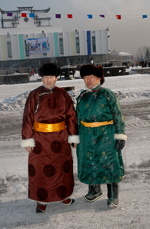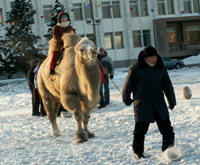Monday was an official day off in Tuva. Since 1991 Shagaa (movable according to the Lunar Calendar) and the Day of the Republic (August, 15)  have been celebrated officially after decades of oblivion. January, 30 this time was fixed by the Resolution of the Great Khural of Tuva as the festive day based on the recommendations of the Tuva's Kamby-Lama. Night preachings took place in all the lamaseries of the republic and in the Drama theatre as well. People tried to fight the sleep as it is a general belief that one of the Deities during the night on the Shagaa's eve counts the souls. If you are asleep you won't be counted and will be devoide of a large portion of happiness. At dawn shamans held a san salyry ritual by the Yenissey river. During the daytime street performances, sports events, games and funs took place on have been celebrated officially after decades of oblivion. January, 30 this time was fixed by the Resolution of the Great Khural of Tuva as the festive day based on the recommendations of the Tuva's Kamby-Lama. Night preachings took place in all the lamaseries of the republic and in the Drama theatre as well. People tried to fight the sleep as it is a general belief that one of the Deities during the night on the Shagaa's eve counts the souls. If you are asleep you won't be counted and will be devoide of a large portion of happiness. At dawn shamans held a san salyry ritual by the Yenissey river. During the daytime street performances, sports events, games and funs took place on  the main square of the city. the main square of the city.The Shagaa holiday dates back from ancient tirmes. Its historical roots suggest its popular origin and that in its basis the holiday has nothing to do with religion. As far back as during the reign of Genghis Khan the holiday was celebrated on autumnal equinox, September 22nd.  In 1267 Genghis Khan's grandson Kublai Khan shifted the celebration to February, to the first day of the lunar spring month. As Shagaa became popular, Buddhist clergymen had to take account of it, and came to include it in the religious system. In 1991 Shagaa was given the status of a state holiday and it was the beginning of a large-scale revival of national customs and traditions, including religious values. Early on Monday in Tuva's every house people observed the rite of worshipping spirits, who were believed to be the masters of that locality. Shagaa calls on people to drop in at each other's place more often, to wish happiness and health and to turn to their ancestors' wisdom: may your thoughts be clean and your future bright.
|
